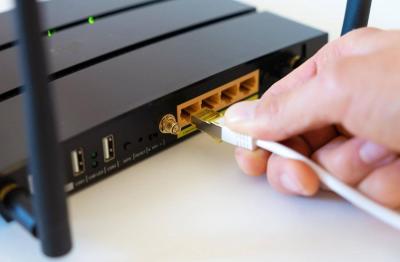
If you're thinking of switching broadband suppliers, one factor you'll probably be thinking about is the installation process.
Will you have to take a day off work? Will you lose internet access while it happens? And how long does the whole thing take?
The answers to all these questions and more depend on which providers you're switching to and from. So let's take a look.
Openreach providers
Most of us have broadband from a supplier that uses the BT-owned Openreach network. These include the likes of Sky, BT, Plusnet, TalkTalk, Vodafone and most other major brands.
If you move from one Openreach provider to another you'll be able to self-install your broadband. And there's nothing to it:
- Your new supplier will send you a new router and inform you of the activation date.
- When the day comes, plug the new router into the master phone socket and turn it on.
- Wait for it to be connected.
And that's about it. You might lose your internet signal for an hour or so while the switchover happens, and you will have to connect all your devices to the new router with the new password. But beyond that, it really couldn't be easier.
The only caveat here is that you do need to have a live BT phone line in your home. If you're already with an Openreach-based provider then you've obviously already got one.
But if you aren't, you can check to see if you've got a master socket in your house. It's usually a small white box with a BT logo and a couple of phone ports on it. If you find one (and you don't already use it), it's likely a disconnected line that may be re-connected remotely.
If you haven't got one, you'll need an engineer to visit to install a new line. This can take anywhere up to three weeks to arrange. Though you'll have to pay for it, the price will vary depending on which provider you're going with.
Virgin Media installation
Switching to Virgin Media requires a more involved installation process unless your home has been connected to Virgin previously.
Because Virgin Media use their own cable network infrastructure, your home needs to be hooked up to their network for you to connect. If it already has been - either because you're a previous customer or someone who lived in your home before you was - then you can use the Virgin Media QuickStart installation to get going.
This is a self-install system that gives you a box containing all the gear you need, along with an app to walk you through the process of plugging the cables into the right ports, along with anything else you need to know. You can be up and running in as little as four days if you choose this option.
But if your home hasn't been connected to the Virgin network before you will need an engineer to come and get you connected:
- You get to choose the day and time for installation when you place your order, and you need to be in when it happens.
- During installation, the engineer will run a cable from the pavement to a wall box they'll mount on the outside of your house. This may go underground or beneath your lawn, but they'll decide on the best route after consulting you.
- The engineer will then install further cables to entry points inside your home, which will require them to drill a small hole in your wall.
- They'll then complete the setup to ensure it's all up and running as you expect.
- The process should take between 30 minutes and two hours.
If you're renting you might need to get permission from your landlord before you go ahead with the install.
Full fibre installation
Unless your home is already equipped with a full fibre connection, you'll need an engineer to visit to install it for you. The process - as well as the setup fee - varies slightly depending on which provider you're using, but the basics are as follows:
- The engineer will run a fibre cable from the access point on the pavement outside your home through a hole they'll drill in your outside wall. (Some areas might use overhead cables instead.)
- This hole will typically be up to 1cm in diameter and often positioned near your front door.
- They'll then install a fibre socket inside. Both your fibre cable and Wi-Fi router will be plugged into this.
- Finally, they'll complete the setup to make sure it's all working. The installation should take around an hour.
While installation is one of the factors you need to consider when thinking about switching broadband providers, you shouldn't be put off by the prospect. Even if you need an engineer to install it for you the process will usually only take a couple of hours at most. In a lot of cases, you'll be able to do it yourself with almost no trouble at all. Some providers do charge a setup or installation fee, but we've published all the deals without any upfront costs.
Are you ready to shop for a new broadband provider? Use our postcode checker to find the best deals on fibre, cable and full fibre broadband available in your street today.
Posted by Andy Betts on in Features
